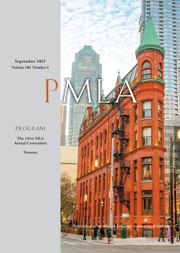No CrossRef data available.
Article contents
Put Some Red on It: Maoist Brooding and Communist Laughter
Published online by Cambridge University Press: 01 September 2025
Abstract
An abstract is not available for this content so a preview has been provided. Please use the Get access link above for information on how to access this content.
Information
- Type
- Theories and Methodologies
- Information
- Copyright
- © 2025 The Author(s). Published by Cambridge University Press on behalf of Modern Language Association of America
References
Works Cited
Adorno, Theodor W., and Horkheimer, Max. Dialectic of Enlightenment. 1944. Translated by Cumming, John, Continuum Publishing, 1999.Google Scholar
Althusser, Louis. “From Capital to Marx’s Philosophy.” Reading Capital, by Althusser et al., translated by Ben Brewster and David Fernbach, Verso, 2015, pp. 9–72.Google Scholar
Badiou, Alain. The Communist Hypothesis. Translated by Macey, David and Corcoran, Steve, Verso, 2010.Google Scholar
Badiou, Alain. “One Divides into Two.” The Century, translated by Toscano, Alberto, Polity, 2007, pp. 58–67.Google Scholar
Baraka, Amiri. “Allah Mean Everything!” Newark Review, vol. 2, set 4, 1999, web.njit.edu/~newrev/v2s4/Allah.html.Google Scholar
Baraka, Amiri. “The ‘Blues Aesthetic’ and the ‘Black Aesthetic’: Aesthetics as the Continuing Political History of a Culture.” Black Music Research Journal, vol. 11, no. 2, autumn 1991, pp. 101–09.CrossRefGoogle Scholar
Baraka, Amiri. “Fashion This, from the Irony of the World.” African American Review, vol. 37, nos. 2–3, summer-fall 2003, pp. 194–98.Google Scholar
Baraka, Amiri. Negroes Older. 4 Dec. 2003.Google Scholar
Baraka, Amiri. “Somebody Blew Up America” and Other Poems. House of Nehesi Publishers, 2003.Google Scholar
Benjamin, Walter. The Arcades Project. Translated by Eiland, Howard and McLaughlin, Kevin, Belknap Press, 1999.Google Scholar
Benjamin, Walter. “Try to Ensure That Everything in Life Has a Consequence.” 1932. Translated by Livingston, Rodney. Walter Benjamin: Selected Writings, Vol. 2, Part 2, 1931–1934, edited by Michael W. Jennings et al., Harvard UP, 1999, p. 686.Google Scholar
Brecht, Bertolt.
Refugee Conversations
. Edited by Tom Kuhn, translated by Romy Fursland, Methuen, 2020.CrossRefGoogle Scholar
Castro, Fidel. “Words to Intellectuals.” Fidel Castro Reader, edited by Deutschmann, David and Shnookal, Deborah, Ocean Press, 2007, pp. 213–39.Google Scholar
Edwards, Brent Hayes. Epistrophies: Jazz and the Literary Imagination. Harvard UP, 2017.Google Scholar
Franklin, H. Bruce. Prison Literature in America: The Victim as Criminal and Artist. Oxford UP, 1989.Google Scholar
Glick, Jeremy Matthew. “Fredric Jameson and Gayatri Chakravorty Spivak’s Periodizing the Black Internal Colony.” CLCWeb: Comparative Literature and Culture, vol. 24, no. 1, 2022, https://doi.org/10.7771/1481-4374.4293.Google Scholar
Halpern, Richard. Eclipse of Action: Tragedy and Political Economy, U of Chicago P, 2017.CrossRefGoogle Scholar
Karl, Rebecca E. China’s Revolutions in the Modern World: A Brief Interpretive History. Verso, 2020.Google Scholar
Sombart, Werner. Why Is There No Socialism in the United States? 1906. Edited by Husbands, C. T., translated by Patricia M. Hocking and Husbands, M. E. Sharpe, 1976.CrossRefGoogle Scholar
Wizisla, Erdmut. Walter Benjamin and Bertolt Brecht: The Story of a Friendship. Yale UP, 2009.CrossRefGoogle Scholar
Woods, Billy. “Cuito Cuanavale.” YouTube, uploaded by backwoodz studioz, 27 June 2013, www.youtube.com/watch?v=gXiUfZXMsCA.Google Scholar

